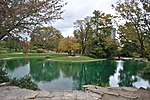Eden Park Station No. 7
1880s architecture in the United StatesBuildings and structures completed in 1889Buildings and structures in CincinnatiEclectic architectureFormer pumping stations ... and 4 more
National Register of Historic Places in CincinnatiSamuel Hannaford and Sons Thematic ResourcesVictorian architecture in OhioWater supply infrastructure on the National Register of Historic Places

The Eden Park Station No. 7 is a historic structure located in Eden Park in Cincinnati, Ohio, United States. Constructed in the late nineteenth century as a significant part of the city water supply system, it was used for its original purpose for only a few decades. As a work of Cincinnati's most important architect, it has been named a historic site.
Excerpt from the Wikipedia article Eden Park Station No. 7 (License: CC BY-SA 3.0, Authors, Images).Eden Park Station No. 7
Martin Drive, Cincinnati Walnut Hills
Geographical coordinates (GPS) Address External links Nearby Places Show on map
Geographical coordinates (GPS)
| Latitude | Longitude |
|---|---|
| N 39.113055555556 ° | E -84.491111111111 ° |
Address
Eden Park Station No. 7
Martin Drive
45206 Cincinnati, Walnut Hills
Ohio, United States
Open on Google Maps










